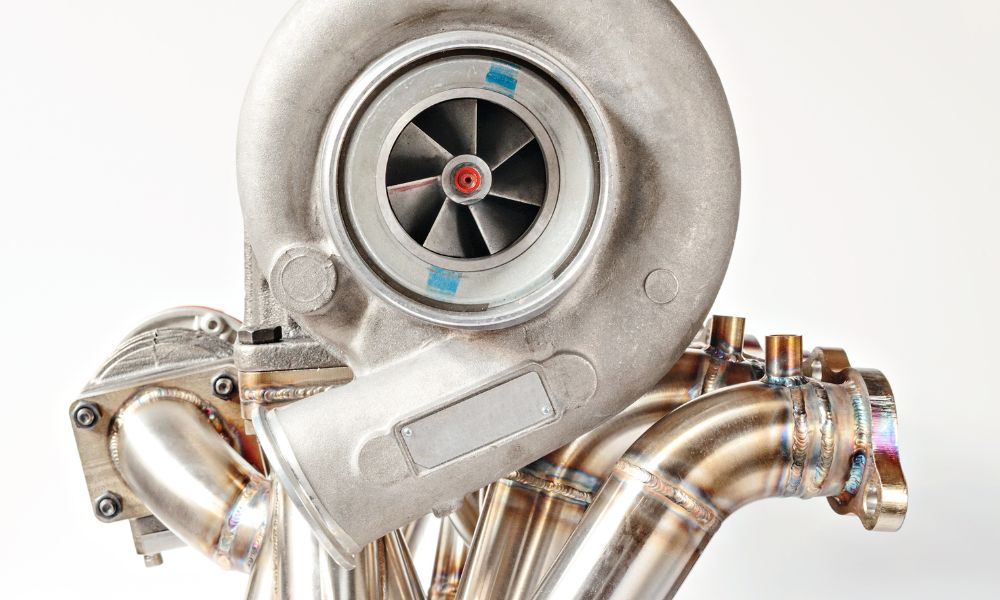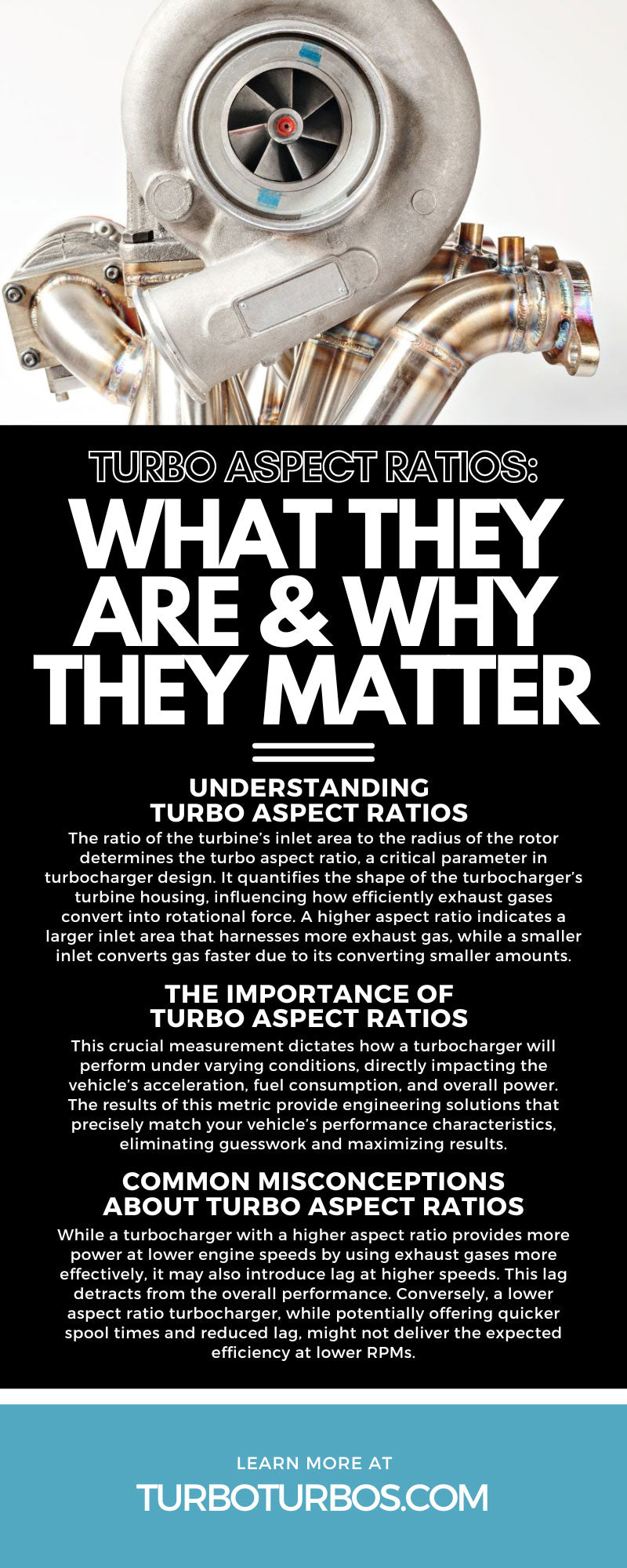
In high-performance automotive engineering, the turbo aspect ratio is a pivotal factor in optimizing engine efficiency and power output. By understanding the turbo aspect ratio and why it matters, enthusiasts and professionals alike will unlock the full potential of their vehicles. Learn more about the turbo aspect ratio and why it’s a considerable measurement of a turbo’s prowess.
Understanding Turbo Aspect Ratios
The ratio of the turbine’s inlet area to the radius of the rotor determines the turbo aspect ratio, a critical parameter in turbocharger design. It quantifies the shape of the turbocharger’s turbine housing, influencing how efficiently exhaust gases convert into rotational force. A higher aspect ratio indicates a larger inlet area that harnesses more exhaust gas, while a smaller inlet converts gas faster due to its converting smaller amounts.
The Importance of Turbo Aspect Ratios
Measuring the turbo aspect ratio is essential for any turbocharged vehicle. For performance enthusiasts and automotive professionals, selecting a turbocharger with the right aspect ratio is the key to unlocking unparalleled engine performance and efficiency.
This crucial measurement dictates how a turbocharger will perform under varying conditions, directly impacting the vehicle’s acceleration, fuel consumption, and overall power. The results of this metric provide engineering solutions that precisely match your vehicle’s performance characteristics, eliminating guesswork and maximizing results.
Common Misconceptions About Turbo Aspect Ratios
A prevalent misconception regarding turbo aspect ratios is that “bigger is always better.” Many enthusiasts believe opting for a turbocharger with a higher aspect ratio will yield increased power and efficiency across all engine speeds. However, this is not necessarily the case.
While a turbocharger with a higher aspect ratio provides more power at lower engine speeds by using exhaust gases more effectively, it may also introduce lag at higher speeds. This lag detracts from the overall performance. Conversely, a lower aspect ratio turbocharger, while potentially offering quicker spool times and reduced lag, might not deliver the expected efficiency at lower RPMs.
The Impact of Different Turbo Aspect Ratios
The impact of different turbo aspect ratios on a turbocharger’s performance is essential to consider. For instance, a turbocharger with a high aspect ratio, such as 1.15, is an excellent choice for a heavy-duty truck engine that requires strong performance from a standstill. This ratio boosts early torque delivery and enhances low-speed drivability. In contrast, a sports car engineered for high-speed track performance may benefit more from a turbocharger with a lower aspect ratio. A 0.85 ratio offers faster spool times and minimizes turbo lag at high speeds, thus maintaining a sharp acceleration curve.
Choosing the Right Turbo Aspect Ratio
When choosing the right turbo aspect ratio for your vehicle, it’s essential to consider a few critical factors to ensure an optimal match with your driving needs and engine characteristics. Assess the primary use of your vehicle—whether it’s for daily driving, towing, racing, or a combination of these. Vehicles used mainly for towing or carrying heavy loads benefit from a turbocharger with a higher aspect ratio for improved low-end torque and power.
A lower aspect ratio is often better for racing or high-speed driving, offering quicker spool times and reduced turbo lag. Additionally, consider the engine size and type, as well as any existing modifications, as these significantly influence the optimal aspect ratio and how the turbo fits on the engine.
Turbo Aspect Ratios and Fuel Efficiency
A turbocharger with an optimal aspect ratio enhances the engine’s breathing efficiency, allowing for better air-fuel mixture combustion. This improvement in combustion efficiency boosts power output and enhances fuel economy, as the engine does more work with the same amount of fuel or even less.
Specifically, a turbocharger that operates efficiently within an engine’s most common RPM range reduces the need for throttle application, leading to a decrease in fuel consumption. Consequently, selecting a turbocharger with the right aspect ratio is essential for drivers seeking to maximize their vehicle’s performance while keeping an eye on fuel efficiency.
Turbo Aspect Ratio and Turbo Responsiveness
Understanding the critical role of turbo aspect ratios in determining turbo responsiveness is fundamental when seeking optimized vehicle performance. Aspect ratio significantly influences a turbocharger’s responsiveness or its ability to quickly reach its full performance potential.
Turbochargers with a lower aspect ratio typically spool up more rapidly, delivering power with minimal delay, making them ideal for those requiring immediate throttle response. In contrast, turbochargers with a higher aspect ratio may offer a delayed response but sustain power output more efficiently over a broader RPM range, suited for scenarios demanding sustained power. Understanding these aspects is essential to choosing the best turbo for your vehicle and helping it reach its fullest potential.
Aspect Ratio Relating to Turbo Spool, Power, and Flow
A turbo’s increasing rotational speed to achieve maximum efficiency, power output, and the amount of air flowing through it—or its spool, power, and flow— are essential parts of the device that the aspect ratio affects. A carefully selected aspect ratio dramatically enhances a turbocharger’s efficiency, tailoring its performance to match the unique demands of any vehicle. Lower aspect ratios foster quicker spool times, offering snappier power delivery ideal for those seeking immediate throttle response.
On the flip side, a higher aspect ratio turbocharger excels in maximized power output over a broader RPM range, ensuring sustained performance crucial for high-speed endeavors. Furthermore, the aspect ratio directly influences the turbo’s flow capacity, affecting how it manages exhaust gases to optimize power and efficiency.
Is It Possible To Change a Turbo’s Aspect Ratio?
The possibility of altering a turbocharger’s aspect ratio is a topic that generates considerable interest among automotive enthusiasts eager to customize their vehicle’s performance. In theory, modifying a turbo’s aspect ratio involves significant changes to the turbine housing and, potentially, the compressor housing, making it no small feat.
Such modifications require precision engineering and an in-depth understanding of turbocharger mechanics, as even minor adjustments profoundly impact the turbo’s behavior and efficiency. Understanding the manufacturing process for various brands of turbos, such as Garret or Cummins, is also important if you plan to change the design.
While technically possible, the complexity and cost often make it impractical for most applications. Instead, select a turbocharger from a reliable Garret turbo dealer like TurboTurbo for the most effective way to achieve desired performance enhancements.
Troubleshooting Turbo Aspect Ratio Issues
When diagnosing and troubleshooting issues related to turbo aspect ratios, it’s crucial to consider symptoms such as unexpected turbo lag, decreased fuel efficiency, or inconsistent power output across RPM ranges. These issues often stem from a mismatch between the turbocharger’s aspect ratio and the engine’s operating characteristics or the intended application.
Effectively address these problems with a comprehensive evaluation of the turbocharger’s performance in conjunction with engine diagnostics. This approach ensures any adjustments or replacements of the turbocharger accurately resolve the specific performance shortfalls.
The turbo aspect ratio is pivotal in turbocharger performance, impacting power output, fuel efficiency, and responsiveness across various engine speeds. Understanding the turbo aspect ratio and why it matters gives you the wisdom to choose the right turbocharger for your vehicle. Keep the aspect ratio in mind as you browse TurboTurbo’s products and find the right option for your engine.

